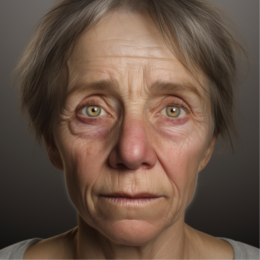13 Ways to Create a Dementia-Friendly Environment at Home

We thought you might like these too:
- How to Care for Someone With Dementia? Expert Tips & Advice
- What Are the 7 Stages of Vascular Dementia?
- Activities For People With Dementia: 10 Fun No-Fail Ideas
- What Is Lewy Body Dementia: Understanding the Disease and Its Implications
- 7 Ways to Reduce Dementia Sundowning Symptoms
Meet Janet. A spirited, 70-year-old retiree, she’s spent most of her life working as a nurse, helping others navigate the challenges of health. Now, she finds herself facing a personal challenge. Her once photographic memory is beginning to fade, and she’s been diagnosed with early-stage dementia. For Janet and many like her, creating a dementia-friendly environment at home becomes crucial. But what does that really entail?
Importance of Creating a Dementia-Friendly Environment
Statistics:
- According to the World Health Organization, approximately 50 million people worldwide have dementia, with nearly 10 million new cases every year.
- 60-70% of dementia cases are attributed to Alzheimer’s disease.
Living with dementia isn’t just about the diagnosis; it’s about the quality of life afterward. A dementia-friendly environment reduces the risks of accidents, improves self-sufficiency, and offers a sense of familiarity and comfort.
Imagine how you’d feel if everyday objects and paths in your home suddenly seemed unfamiliar or dangerous. That’s the world many with dementia navigate daily.
Quick Poll
13 Ways to Create a Dementia-Friendly Environment at Home
Reduce Clutter

Decluttering is about more than just aesthetics; it’s about creating a clear and understandable space for someone with dementia. Clutter can be overwhelming, causing undue stress, anxiety, and confusion. The brain with dementia already faces challenges with processing, and excessive items or disorganization can exacerbate these difficulties.
Clear Pathways
Creating clear pathways is paramount for ensuring safety and ease of navigation for individuals with dementia. As dementia progresses, spatial awareness can become compromised, making once-familiar environments seem challenging or disorienting.
Good Lighting
Lighting plays a pivotal role in shaping the environment for someone with dementia. As the disease progresses, individuals may experience changes in their visual perception, making adequate and appropriate lighting even more vital for daily tasks and overall well-being.
Well-lit spaces can reduce the likelihood of trips and falls, as shadows or dim areas can be misinterpreted as obstacles or voids. In particular, transitional spaces, such as hallways or the area between rooms, should be given special attention. Ensuring that these areas have consistent lighting can prevent disorientation or hesitation when moving from one space to another.
Color Contrast
Color contrast is an essential design element, especially when catering to the needs of individuals with dementia. As dementia progresses, the ability to perceive and differentiate between certain colors and shades can diminish. Thus, introducing clear color contrasts in the environment can drastically improve spatial understanding and reduce feelings of confusion or disorientation.
Label and Organize
The art of labeling and organizing can be a game-changer when optimizing a living space for someone with dementia. As memory lapses become more common, visual cues and clear organization can empower the individual, promoting independence and reducing feelings of frustration or anxiety.
Labels serve as direct reminders, guiding individuals in their daily tasks. Using both text and images can be particularly effective. For instance, a picture of a shirt along with the word “clothes” can be used on a wardrobe. Similarly, an image of a spoon and fork alongside the word “utensils” can label kitchen drawers.
Remove Hazards
Ensuring a safe living environment for individuals with dementia goes beyond basic home safety measures; it involves a keen understanding of the unique challenges they face. As cognitive abilities change, seemingly innocuous household items or setups can become potential hazards. Addressing these proactively can significantly reduce the risk of accidents or injuries.
Comfortable Furniture
The furniture in a home, beyond its aesthetic appeal, plays a pivotal role in the comfort and safety of individuals, especially those with dementia. As mobility and sensory perception can become compromised, selecting the right furniture becomes an exercise in balancing functionality, comfort, and safety.
Routine and Consistency
In a world that can often seem unpredictable and confusing for those with dementia, maintaining routine and consistency stands as a pillar of stability and comfort. As memory and cognitive functions become compromised, the regular rhythms and patterns of daily life can provide a reassuring anchor, fostering a sense of security and well-being.
A structured daily routine offers predictability. Knowing what to expect next — be it mealtime, a favorite TV show, or a short walk in the garden — can significantly reduce anxiety. This structure does not just ease the mind but can also help with physical regulation, such as sleep patterns and appetite.
Safety Measures
When accommodating someone with dementia, it’s paramount to prioritize their safety, given that cognitive changes can often lead to unforeseen risks in everyday environments. Implementing effective safety measures ensures not only their physical well-being but also offers peace of mind to caregivers and family members.
One of the foremost concerns in homes is the risk associated with kitchens. Equip stoves with safety knobs or automatic shut-off features to prevent potential fires or gas leaks. Refrigerator locks can be handy in preventing the consumption of spoiled foods, and locked cabinets can keep harmful chemicals or sharp tools out of reach.
Sensory Stimulation
Sensory stimulation is a cornerstone of holistic dementia care, offering therapeutic benefits that engage the mind, body, and emotions. As memory and cognitive functions may wane, the senses—sight, touch, taste, smell, and sound—often remain as powerful connectors to the world, emotions, and past memories.
Memory Aids
In the context of dementia, memory aids serve as valuable tools that help bridge the gap between past recollections and present moments. By anchoring individuals to their personal histories and routines, these aids can enhance their sense of identity, independence, and confidence.
Photo albums and memory boxes are classic examples. Filled with photographs, trinkets, and mementos from significant life events, they provide tangible touchpoints to personal histories. Discussing these items can stimulate conversations, allowing individuals to share stories and relive memories.
Quiet Spaces
In the hustle and bustle of everyday life, quiet spaces become sanctuaries for individuals with dementia. As sensory processing and cognitive functions change, environments that once felt comforting can become overwhelming or overstimulating. Designing and prioritizing quiet spaces within the home environment can be a balm, providing a reprieve from sensory overload and granting moments of calm and introspection.
Supportive Communication
For individuals with dementia, the act of communication evolves into more than just exchanging words; it becomes a lifeline for expressing needs and emotions and maintaining connections. Supportive communication emphasizes understanding, patience, and the holistic approach of using both verbal and non-verbal cues to ensure effective dialogue.
Active listening is foundational. It involves not just hearing the words but understanding the emotions and needs behind them. It might mean reading between the lines or even beyond the words when speech becomes challenging. Maintaining eye contact, nodding, and mirroring emotions can validate the individual’s feelings, letting them know they’re being understood.
Conclusion
Janet’s story serves as a reminder of the power of adaptability and resilience. Creating a dementia-friendly environment is more than just about safety; it’s about ensuring a life of dignity, respect, and love. Remember, the heart remembers what the mind forgets.
DO YOU HAVE ANY PERSONAL TIPS OR EXPERIENCES SIMILAR TO JANET’S JOURNEY? SHARE THEM BELOW, AND LET’S FOSTER A COMMUNITY OF SUPPORT!
References
World Health Organization. Dementia.
Alzheimer’s Association. Living with Alzheimer’s.





